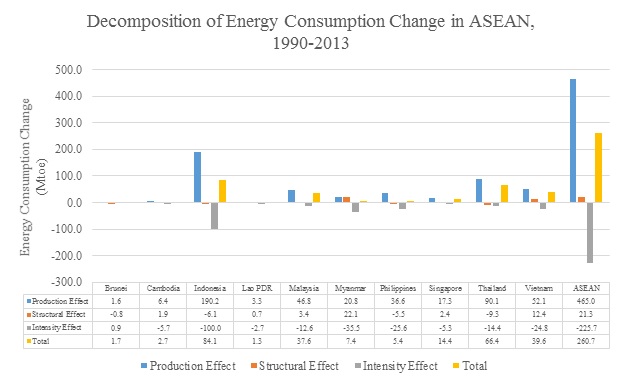Menu
ASEAN is one of the most dynamic and fastest-growing regions in the world, with a remarkable economic growth of 5.1% per year from 1990 to 2013. During the same period, its total final energy demand had increased about 2.5 times from 176 to 437 Mtoe, or an average growth of 4.0% per year¾more than twice the world’s growth rate. Under the Advancing Policy Scenario of the 4th ASEAN Energy Outlook, energy demand is expected to continue growing at least 3.5% per year until 2035 (ACE, 2015). With this regard, it is obligated to investigate the reasons behind the increased energy demand during the last two decades.
The study conducted at the ASEAN Centre for Energy (ACE) aims to provide an understanding of the relation between economic activity and the change in energy consumptions, as well as to identify the contributing factors in the region and in each ASEAN Member State (AMS). The study adopted a decomposition method to quantify the underlying drivers of changing energy consumption. With this methodology, the changes in energy consumptions are classified into 3 (three) types of factor; activity effect, structural effect, and intensity effect. Activity effect relates to the expansion of economy which also attributes to the increase of goods and services produced. The structural effect quantifies the contribution of economic structure adjustment to the energy consumptions. The intensity effect measures the improvement of efficiency relating to applied technology to produce the goods and service.
 Figure 1. Decomposition of Energy Consumption Change in ASEAN,1990-2013
Figure 1. Decomposition of Energy Consumption Change in ASEAN,1990-2013
Figure 1 shows the results of the decomposition of energy consumption changes in ASEAN. The key findings of the study are as follows:
Reference
ACE (2015). The 4th ASEAN Energy Outlook 2013-2035, Jakarta.
The study was conducted by ACE’s former intern (August 2016), Mr Fahman Fathurrahman, as part of his studies as a PhD candidate in Earth System Science Graduate Program, Middle East Technical University in Turkey.
